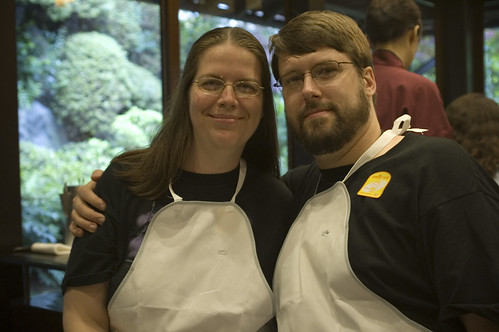When we last left our travelers (myself and my husband Aaron, that is), the Dynamic Tokyo Tour was leaving Happo-en Garden and heading toward Chinzanso Gardens for a Japanese BBQ lunch at Mokushun-do Restaurant.
You may recall that, at the very beginning of the tour, our tour guide had asked us if both beef and pork were OK for lunch. We’re crazy omnivorous Americans, so we agreed that both were fine. En route to Chinzanso, Junko asked again for a show of hands of who didn’t want beef, and who didn’t want pork. After a quick count, she seemed perplexed, and told us that some people had apparently changed their minds, because the counts were different than earlier. After two more shows of hands, Junko finally went through the entire bus one more time, asking everyone individually whether they wanted only beef or only pork, and making it clear that it would *not* be OK for us to change our minds after this point. Being that this didn’t really affect us directly, the whole scene was more amusing than anything else.
Japanese BBQ, as with other styles of Asian BBQ, involves a server cooking the food at your table. At Mokushun-do, we were served pork, beef, sweet onion, asparagus, and Japanese sweet potato, all grilled at the table and dipped in a light BBQ sauce before serving. Each table at the restaurant was equipped with a large square griddle in the center; we could feel the heat put off by the griddle at our table before we even sat down. All of the tour participants sat six to a table, two on a side, with one side of the table reserved for the chef/server. Aaron and I ended up sitting with a younger couple and an older couple, who both turned out to be from Sweden.
That was one interesting aspect of our English-speaking tour: most of the tour participants were not native English speakers. There were Swedish people, Japanese people, and I’m sure there were other nationalities and languages being represented, as well. English just seemed to be a common second (or third) language for most of these people. It made the tour more interesting, I think — especially during the earlier tea ceremony, when Junko-san had to repeatedly tell the Japanese-speakers to please be quiet until the end of the ceremony.
Back to lunch. Our server came around and tied apron-bibs onto all of us who were seated at her table. The photo ops that ensued became yet another way for us to meet our fellow tourists and get photos of ourselves:
It was at this point when we learned that our table-mates were all Swedish — and, no, the two couples were not together. They were visibly excited to learn that they were compatriots, which was fun to see. It was also fun to see other people use up all the conversational English they knew. ^_^
As our server put the meat and vegetables on the griddle, she would tell one person in the group what it was. There was one item that Aaron and I didn’t catch, though, and that eventually offered me an opportunity to use my Japanese again. We were served one piece of meat and one vegetable at a time: pork and asparagus, beef and onion, etc. When the mystery item was served, I got our server’s attention and asked, “Kore wa nan desu ka?”
“Japanese sweet potato,” she said in highly accented Japanese — so it came out “Japanesu suweetu potehto.” Then she told us that it was very different from normal sweet potato, and we agreed and thanked her. After she told us, we could totally tell that’s what it was. The insides were white and the skin looked purple, but the texture and taste became immediately more recognizable, once we knew what it was.
A moment later, our server gestured to my chopstick hand and said, “Good chopstick!” I thanked her, once her meaning sank in (I forget whether I did so in English or Japanese), and Aaron and I briefly compared chopstick styles. Aaron uses kind of his own style, while I do it the way that the disposable chopstick wrappers describe, with their pictures and their great Engrish. Our server saw the way Aaron and I were silently comparing notes, and how Aaron was realizing that he was doing his chopsticking some kind of effed-up way, and she giggled. It was a cute moment.
After four or five mini-courses, we had a dessert of vanilla bean ice cream (with cute little spoons!) and a different kind of tea than the standard green tea served with lunch. After dessert, we were given 30 minutes to walk the grounds and make our way back to the bus. Aaron went to untie his apron-bib, and our server jumped into action and apologized, helping him remove his bib. The level of service in Japan is really an experience in itself.
We made a quick restroom break at the restaurant, then headed out to see the grounds — in the rain. Luckily, Chinzanso was kind enough to provide umbrellas for their guests, so we each borrowed an umbrella and struck out into the rain. I would have liked to have spent more time in the gardens, as there was so much to see: a 500-year-old sacred tree, with branches held up by crutches; Shiratama Inari Shrine, a three-story pagoda, and various gods/idols and water features and bridges and such. Alas, we barely had time to check out the few things we did, and the rain really started to come down as we were walking. We made it back to the main building on time, dropped off our umbrellas in the waiting rack, and headed out to the bus. Next stop: the Imperial Palace.
Previous: Day 2, Part 2: Tokyo Tower and Happo-en Garden | Next: Day 2, Part 4: Imperial Palace and Sumida River Cruise
